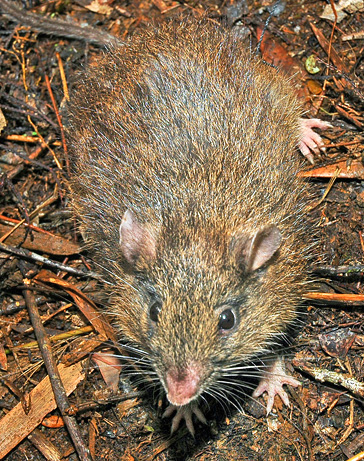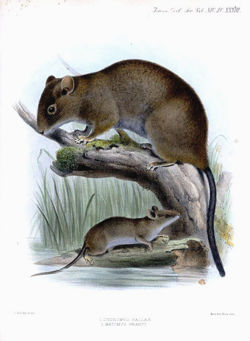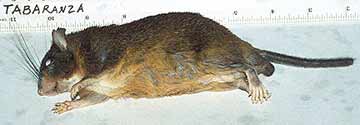New Rodent Discovered in Philippines ~ [Updated w/ Photo]
Posted by: Loren Coleman on February 19th, 2009

Update: National Geographic is sharing the above photograph of this new species, on February 19, 2009.
++++++

The Luzon Forest Rat or Luzon Hairy-Tailed Rat, Batomys granti, pictured on the ground, is a close relative of the new species, just discovered. (Crunomys fallax, the Northern Luzon Shrew Rat, is shown above it and is only known from one specimen, the holotype, collected in 1895/1896.)
A new species of rat has been found on a mountain in the southern Philippines, the environment department said on Wednesday, February 18, 2009.
Scientists have confirmed that a small rodent found only on Mount Hamiguitan (known for its bonsai forest) in Davao Oriental and discovered two years ago by the Philippine Eagle Foundation (PEF) and the Chicago-based Field Museum of Natural History is a new species.
The Hamiguitan batomys or Hamiguitan hairy-tailed rat is a yellow-brown animal with a long furry tail, weighs about 175 grams, and is related to several other species in Central Mindanao, Dinagat Island and Luzon. It lives only from an elevation of 950 meters and up in dwarf mossy forests of areas less than 10 square kilometers.
Environment Secretary Lito Atienza said the discovery and confirmation bolster his department’s efforts at protecting and enhancing biodiversity and the preservation of natural resources. “We have long taken great pride in our wealth of flora and fauna, and this new discovery reinforces our efforts to make the protection of these unique and endemic species found in the country our top priority.”
He said experts believe there could be more discoveries of new species in the country, and he worries some of these species may already be threatened with extinction before they are discovered and protected.
Murid rodents of the endemic genus Batomys are diverse and geographically widely distributed in the Philippines. Four species have been recognized: B. dentatus and B. granti on Luzon, B. salomonseni on several islands comprising the Mindanao faunal region, and B. russatus on Dinagat Island. This recent survey of small mammals in eastern Mindanao recorded the presence of Batomys on Mt. Hamiguitan, the only other documented occurrence of this genus on Mindanao Island outside of Mt. Kitanglad.

Dinagat Hairy-tailed Rat, Batomys rusattus, another relative of the new species from the Philippines, is known only from two specimens collected in 1975, and one individual in 1995. No specimens of Batomys rusattus have been found in the 2000s.
Lawrence Heaney, curator of mammals at the Field Museum and coauthor of the new member of the genus Batomys description, said, “The Philippines has one of the largest numbers of unique species of mammals of any place in the world; over 125 mammal species live only in the Philippines. There is truly a wealth of animal and plant life here that is worth protecting.”
Heaney added, “The unusual geological history of Eastern Mindanao leads us to predict that additional species currently unknown to anyone except local residents are likely to live there. Our project with the PEF will attempt to find, formally describe and learn about the habitat needs of these species before logging, mining or other human activities reduce their chances for survival.”
Team leader and lead author Danilo Balete said, “The Hamiguitan batomys is the first mammal to be described from Eastern Mindanao, and is the first mammal that is thought to live only in that area. Most mammals unique to Mindanao were described from Mount Apo or Mount Kitanglad. This points to Eastern Mindanao, especially Mount Hamiguitan, as a biologically unique part of the Philippines.”
The new species was found in May 2006 during an expedition that sought to learn more about the region, which is also home to the globally endangered Philippine Eagle, the country’s national bird.
Dennis Salvador, PEF executive director, said that “Mount Hamiguitan and the rest of Eastern Mindanao is poorly known biologically. Sadly, the region is a mining and logging hotspot.”
“At Mount Hamiguitan, six mining agreements cover more than 17,000 hectares of forest, which is more than half of the mountain’s forest cover. We are working with the Department of Environment and Natural Resources and the Field Museum to learn about the biological diversity and conservation status of the region before habitats get further damaged,” he added.
“Mount Hamiguitan fully deserves to be among the global heritage sites,” said Protected Areas and Wildlife Bureau Director Mundita Lim, whose bureau has endorsed the inclusion of Mount Hamiguitan in the Unesco World Heritage List.
Atienza said the people must leave only to government the protection of our natural riches but that they, too, should do their share in making sure our country’s forests and other natural resources such as the sea and the coastal areas are still there for our grandchildren and great grandchildren.
The Philippines has been declared by scientists as one of only a few countries in the world with mega diverse flora and fauna.

Sources: “New rodent species in Davao,” by Jonathan Mayuga, Business Mirror, February 18, 2009; “A new species of Batomys (Mammalia: Muridae) from eastern Mindanao Island, Philippines,” Proceedings of the Biological Society of Washington 121(4):411-428. 2008; “New mountain rat found,” The Straits Times, February 18, 2009; The IUCN 2008 Red List.

Meanwhile, a giant rat (weighing six pounds with a 12-inch tail and one-inch-long teeth) has been caught in the southern Chinese province of Fujian. Is it a really large Chinese Bamboo Rat, Rhizomys sinensis? Photo: HTTP://NEWS.163.COM
About Loren Coleman
Loren Coleman is one of the world’s leading cryptozoologists, some say “the” leading living cryptozoologist. Certainly, he is acknowledged as the current living American researcher and writer who has most popularized cryptozoology in the late 20th and early 21st centuries.
Starting his fieldwork and investigations in 1960, after traveling and trekking extensively in pursuit of cryptozoological mysteries, Coleman began writing to share his experiences in 1969. An honorary member of Ivan T. Sanderson’s Society for the Investigation of the Unexplained in the 1970s, Coleman has been bestowed with similar honorary memberships of the North Idaho College Cryptozoology Club in 1983, and in subsequent years, that of the British Columbia Scientific Cryptozoology Club, CryptoSafari International, and other international organizations. He was also a Life Member and Benefactor of the International Society of Cryptozoology (now-defunct).
Loren Coleman’s daily blog, as a member of the Cryptomundo Team, served as an ongoing avenue of communication for the ever-growing body of cryptozoo news from 2005 through 2013. He returned as an infrequent contributor beginning Halloween week of 2015.
Coleman is the founder in 2003, and current director of the International Cryptozoology Museum in Portland, Maine.










There’s more species waiting to be described.
A Synopsis of the Mammalian Fauna of the Philippine Islands
The “giant rat” in the below picture looks like a Nutria or Coypu (Myocastor coypus) to me. They’re a semi aquatic rodent introduced from South America in many regions around the world. They live in my backyard here in Oregon, and I’m pretty sure they’re farmed in China for meat and fur. At 6 lbs that would be a young one. There is a big male that like to graze in my yard that is about the size of a cocker spaniel.
This is great news. Every one of these discoveries is important to cryptozoology beyond the even the discovery itself. Finding animals such as this new rodent, is going to lead to more biologists getting in there to study these animals, which in turn could lead to findings of even more spectacular cryptids. In effect, there is a sort of spinoff benefit, with the discovery of one species leading indirectly to the discovery of another.
It often happens with new species discoveries that the new animal was not what was being searched for in the first place, as happened here with the new rodent being found while doing studies on the Philippine eagle. I predict that many cryptids are going to be uncovered in this way in the future, with forestry workers or biologists studying the area or known animals, and happening across quite another creature altogether.
I feel this spin off effect is of great importance. You might not get a whole lot of mainstream interest into searching for, say, hairy hominids, but you’re likely to have a good chance of getting it for studying habitats or new or endangered animals. Every new discovery like this, no matter how small, that gets scientific funding into studying an area holds potentially enormous benefits for uncovering more cryptids.